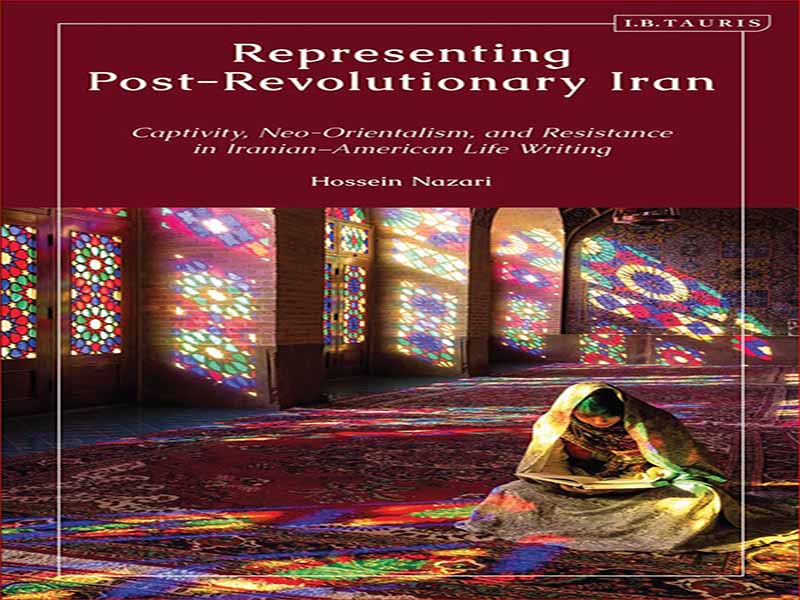- عنوان کتاب: REPRESENTING POST-REVOLUTIONARY IRAN
- نویسنده/انتشارات: Hossein Nazari
- حوزه: ایران
- سال انتشار: 2022
- تعداد صفحه: 232
- زبان اصلی: انگلیسی
- نوع فایل: pdf
- حجم فایل: 8.94 مگابایت
جیل ورال، نویسنده نیوزیلندی، در مقدمه سفرنامه خود، دو بال بلبل: روح ایرانی، قلب اسلامی (2011) می نویسد: «ایران احتمالاً بدفهم ترین کشور جهان است و مردم آن از ترسناک ترین کشورها هستند. ” (ورال). این بیانیه به تنهایی گواهی بر اهمیت ایران، به عنوان یک مکان اصلی در شرق مسلمان، در تخیل غربی، به ویژه در جریان اصلی گفتمان غربی بر ضد دیگری شرقی/مسلمان است. همچنین بیانگر قدرت رژیم نمایندگی است که از طریق آن کشور، مردم آن، و به ویژه دین اصلی آن، اسلام، در غرب، به ویژه در ایالات متحده، در معرض حملات دائمی دیگران، شیطان سازی، به حاشیه رانده شدن و نفی قرار گرفته اند. . این تسلط، فراگیر بودن، اقتدار و پیامدهای جدی فرهنگی و سیاسی چنین بازنمایی هایی است که به تحلیل روشمند و نقد چنین رژیم های تولید دانش درباره دیگری شرقی فوریت می بخشد. بنابراین، این کتاب به دنبال نقد بازنماییهای ادبی ایران است که بخشی از تکثیر تولیدات ادبی حاصل از دو برهه تاریخی تعیینکننده انقلاب اسلامی 1979 ایران – و در آن چارچوب، جنگ ایران و عراق (1980-1980) بود. ) و بحران گروگان (1979-1981) – و آنچه که امروزه معمولاً به عنوان 11 سپتامبر شناخته می شود. مجموعه متون ادبی که به طور خاص به زمینههای ایرانی میپردازند، پس از انقلاب بسیار گسترش یافته و به نقطه اوج خود رسیده است که پروفسور حمید دباشی آن را «بازار یونجه اضطرابهای پس از 11 سپتامبر» (پسا شرقشناسی 276) نامیده است. ساناز فتوحی ثبت کرده است که در حالی که بین سالهای 1980 تا 2001 بیش از شانزده خاطره از ایرانیان مقیم غرب منتشر نشده است، از سال 2001 تا اوایل سال 2012 حداقل پنجاه خاطره دیگر (99) به استثنای مجلدات داستانی و شعر منتشر شده است. روندی که هنوز ادامه دارد. این کتاب با بررسی انتقادی سه خاطرات مهم نوشته شده توسط زنان ایرانی-آمریکایی که آثاری پارادایمیک در بازنمایی آنها از ایران و اسلام تلقی می شوند، تحلیلی بسیار ضروری از این پدیده ادبی در خود-روایت های ایرانی-آمریکایی ارائه می دهد. این سه متن عبارتند از: «بتی محمودی نه بدون دخترم» (1987)، به عنوان نمونه اصلی پیش از 11 سپتامبر از روایتهای اسارت. لولیتا خوانی آذر نفیسی در تهران: خاطره ای در کتاب (2003)، به عنوان نماد نئو شرق شناسی ایرانی-آمریکایی پس از 11 سپتامبر، و به تبع آن در خاورمیانه، خاطرات. و یاس و ستارگان پروفسور فاطمه کشاورز: خواندن بیشتر از لولیتا در تهران (1386)، به عنوان برترین ضد روایت. در حالی که خاطرات زنان ایرانی- اروپایی با خط تیره نوشته شده است، اما هیچ یک از آنها از نظر استقبال مردمی، تأثیر آنها بر درک ایران و اسلام، درگیر شدن با برنامه های سیاسی، جایگاه نمادین سه خاطرات مورد بحث را ندارند. و وضعیت مشهور نویسندگان آنها. علاوه بر این، تنش مداوم در روابط ایران و آمریکا به خاطرات ایرانی-آمریکایی احساس فوریت و موضوعیت می بخشد که در دیگر خاطرات وجود ندارد. تفسیر انتقادی متون مورد بحث اساساً بر اساس نظریه پردازی و نقد ادوارد سعید از مفهوم شرق شناسی در کتاب اصلی او با همین عنوان در سال 1978 و تجلی آخرین روز آن، یعنی نئو شرق شناسی پس از 11 سپتامبر استوار است. . تحلیل این سه متن نمادین به دنبال این است که آشکار کند که علیرغم تفاوتهای صوری و تا حدی موضوعی، روایتهای مورد بحث ایران و اسلام را در چارچوب مرجع مستشرقشناسی دیرینه و از طریق دستگاههای بازنمایی مشابه نشان میدهند. علاوه بر این، اگرچه این متون محصول دو دوره مختلف یعنی قبل و بعد از یازده سپتامبر هستند، اما شباهتهای موجود در زمینههای اجتماعی، سیاسی و تاریخی تولید آنها به ترویج، انتشار و استقبال آنها کمک شایانی کرده است. در ایالات متحده و به طور گسترده تر در غرب.
In the introduction to her travelogue, Two Wings of a Nightingale: Persian Soul, Islamic Heart (2011), the New Zealand author Jill Worrall writes that “Iran is probably the most misunderstood country in the world, and its people are among the most feared” (Worrall). This statement alone is a testament to the significance of Iran, as a major locus in the Muslim Orient, in the Western imaginary, particularly in the mainstream Western discourse apropos the Oriental/Muslim Other. It also bespeaks the power of the representational regime through which the country, its people, and particularly its main religion, Islam, have been subject to constant tropes of Othering, demonization, marginalization, and negation in the West, not least in the United States. It is the dominance, ubiquity, authority, and serious cultural and political implications of such representations that lend urgency to a methodical analysis and critique of such regimes of knowledge production about the Oriental Other. This book, therefore, seeks to critique literary representations of Iran, which were part of the proliferation of literary productions informed by the two defining historical junctures of the 1979 Islamic Revolution in Iran—and within that context the Iran–Iraq War (1980–8) and the Hostage Crisis (1979–81)—and what is now commonly referred to as 9/11. The corpus of literary texts dealing specifically with Iranian contexts has expanded exceedingly since the revolution and reached its apex in what Professor Hamid Dabashi has dubbed “the haymarket of post 9/11 anxieties” (Post-Orientalism 276). Sanaz Fotouhi has recorded that while between 1980 and 2001, no more than sixteen memoirs had been published by Iranians residing in the West, from 2001 to early 2012 at least fifty more memoirs were published (99), excluding works of fiction and poetry volumes—a trend that still continues. This book provides a much-needed analysis of this literary phenomenon in Iranian-American self-narratives, undertaking a critical perusal of three paramount memoirs penned by Iranian-American women, which are deemed to be paradigmatic works in their representations of Iran and Islam. The three texts are Betty Mahmoody’s Not without My Daughter (1987), as the quintessential pre-9/11 example of captivity narratives; Azar Nafisi’s Reading Lolita in Tehran: A Memoir in Books (2003), as the iconic neo-Orientalist post-9/11 Iranian-American, and by extension Middle Eastern, memoir; and Professor Fatemeh Keshavarz’s Jasmine and Stars: Reading More than Lolita in Tehran (2007), as the paramount counter-narrative. While there also exist memoirs written by hyphenated Iranian- European women, none of them share the iconic status of the three memoirs in question, in terms of their popular reception, their impact on the perception of Iran and Islam, their engagement with political agendas, and the celebrity status of their authors. Furthermore, the ongoing tension in US-Iran relations lends a sense of urgency and topicality to Iranian-American memoirs, which is rather lacking in other memoirs. The critical exegesis of the texts in question is built primarily upon Edward Said’s theorization and critique of the concept of Orientalism in his seminal 1978 book of the same title, and its latter-day manifestation, that is, post-9/11 neo-Orientalism. The analysis of the three iconic texts seeks to reveal that notwithstanding their formal and, to a lesser extent, thematic differences, the narratives in question represent Iran and Islam within a long-established Orientalist frame of reference and through similar representational apparatus. Furthermore, even though these texts are products of two different eras, that is, pre- and post-9/11, the similarities in the social, political, and historical contexts of their production have significantly contributed to their promotion, dissemination, and reception in the United States, and more broadly in the West.
این کتاب را میتوانید از لینک زیر بصورت رایگان دانلود کنید:
Download: REPRESENTING POST-REVOLUTIONARY IRAN



































نظرات کاربران